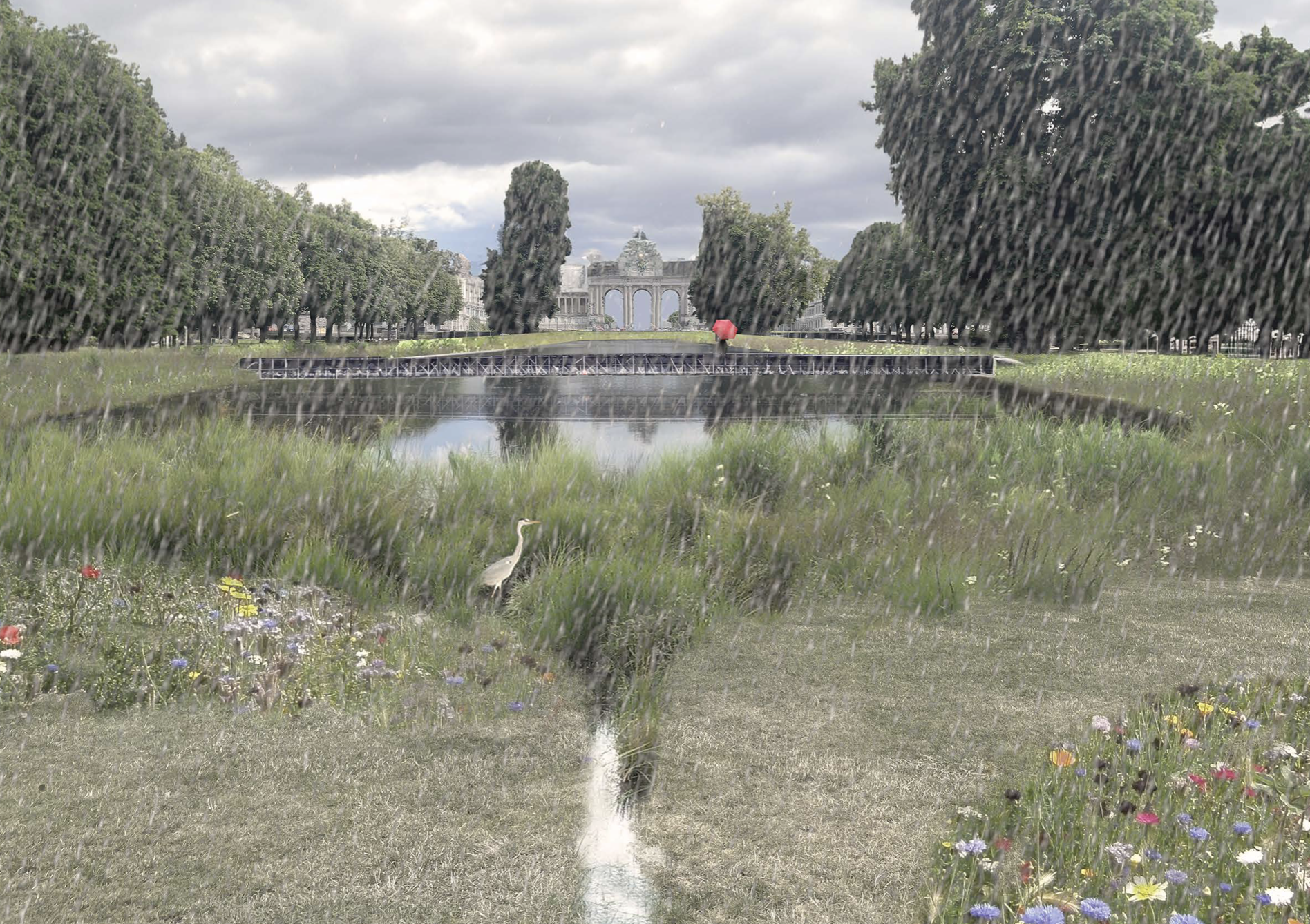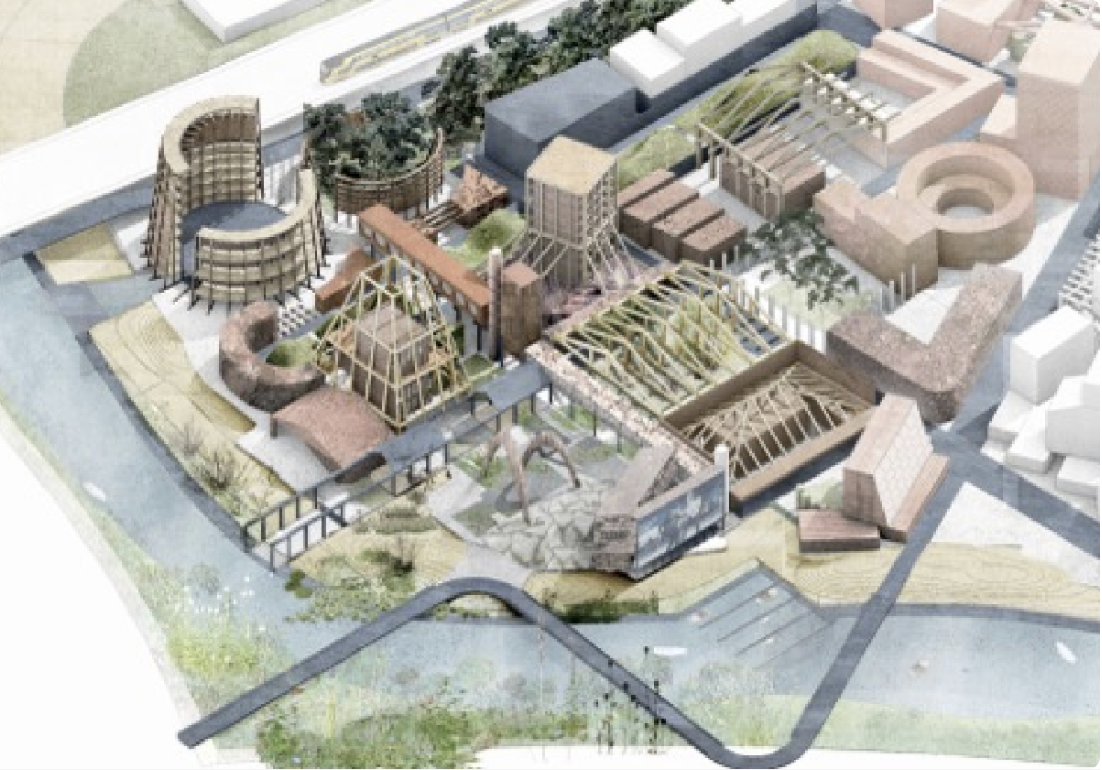Thème
Re-sourcer
La fragilité de l’écosystème Terre et les crises sociales amènent à cultiver des pratiques alternatives aux extractions nocives des ressources, à la surconsommation et à la pollution des milieux vivants. Des projets régénérateurs naturo-culturels sont à imaginer. Il s’agit de tisser des liens synergiques revivifiants entre données biogéophysiques, justice sociospatiale et santé.

Image de projet - Bruxelles (BE) - Lauréat - Re-sourcing through natural elements / risks
1 - Re-sourcer en termes d’éléments naturels / risques
Afin de permettre une alliance avec les milieux habités, il est temps de repenser les puissances vitales combinées entre elles que sont l’eau, l’air, la terre et le feu. Les éléments qui sont des sources précieuses d’énergie et de fertilité, chargés de potentialités symboliques et poétiques s’avèrent aussi liés à des dérèglements, risques et catastrophes qui affectent les lieux et tout l’écosystème terrestre à partir du moment où se trouvent enclenchés des cataclysmes consécutifs à des aménagements délétères.

Image de projet - Makarska (HR) - Mentionné - Re-sourcing through ways of life and inclusivity
2 - Re-sourcer en termes de modes de vie et d'inclusivité
La reconsidération des conditions d’habitabilité passe également par une attention soutenue aux évolutions des modes de vie dans un monde numérique hyper connecté. Des agencements à même de préserver tout à la fois, l’intimité, le commun et les solidarités sont en jeu corrélés à des stratégies bioclimatiques et permaculturelles dans lesquelles humains et non-humains puissent coopérer.

Image de projet - 'T Zoet (NL) - Lauréat - Re-sourcing through materiality
3 - Re-sourcer en termes de matérialité
Le déjà construit constituant désormais un gisement phénoménal de matières, il importe de concevoir des dispositifs de transformation des édifices existants animés par la stratégie des des 3 R (Réduire, Réutiliser, Recycler) : Réduire les constructions neuves.Réutiliser au sens du réemploi des espaces déjà construits et des matériaux. Recycler en faisant appel à des matériaux bio-géossourcés (terre, pierre, fibre), en anticipant la déconstruction et en redevenant local (mobilisation des savoir-faire et des matériaux présents sur les sites d’implantation).
Et ce, afin de favoriser la préservation des ressources naturelles.
Chaque site sera presenté à deux échelles :
- L’échelle territoriale du « site de réflexion » (périmètre rouge) qui fera apparaître les éléments géographiques et écologiques (topographie, géologie, les éléments naturels), les logiques de mobilité et de modes de vie de grande échelle - en utilisant au maximum la cartographie - et qui ont un impact sur le site de projet aujourd’hui et, potentiellement, dans le futur ;
- L’échelle de proximité, celle du « site de projet » (périmètre jaune), où seront présentés de manière claire et précise l’existant (espace physique, nature, modes de vie) et les intentions de la ville pour son évolution dans le futur.
Questions aux concurrents
Le défi pour les concurrents, dans leurs projets-processus, sera de faire converger les trois types de ressourcements car c’est leur croisement qui génèrera un spectre prometteur de projets résilients face à la rareté des ressources et à la vulnérabilité des sites.
Les questions posées sont :
.Quelles sont les nouvelles manières de concevoir pour s'adapter au changement climatique : montée des eaux, pollution de l'air, sécheresse, etc. ?
.Comment introduire dans les projets la régénération et l'assainissement des sols les rendant plus poreux et vivants, augmentant la biodiversité des espaces bâtis, afin de les rendre plus vivables ?
.Comment imaginer de nouveaux scénarios d'usages dynamiques et productifs pour revitaliser des communautés d'humains et de non-humains ?
.Comment inventer une nouvelle matérialité qui puisse résulter de bio-matériaux provenant majoritairement de ressources locales et s'inscrivant dans une logique d'économie circulaire ?
.Comment hybrider dans les équipes les différentes compétences nécessaires à ces projets qui associent la prise en compte des éléments naturels, de nouveaux modes de vie et l'utilisation de bio-matériaux ?
.Quelles échelles franchir pour rendre pertinentes les réponses proposées ? Un projet sur un site de proximité peut-il se combiner avec une réflexion à l'échelle plus large du territoire ? Un projet urbain doit-il aussi se décliner à une échelle de proximité pour illustrer son impact ?